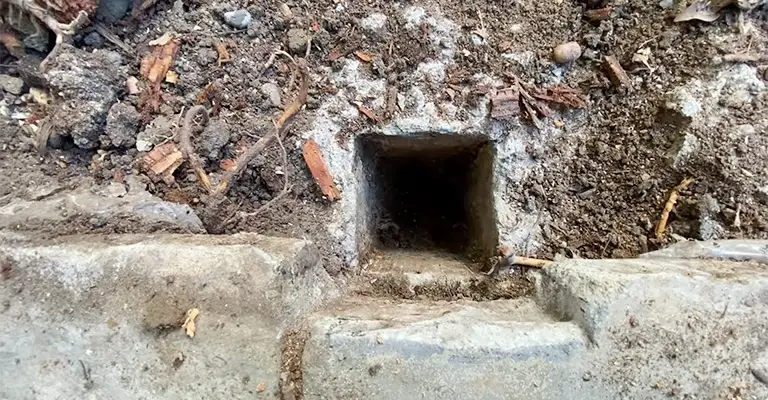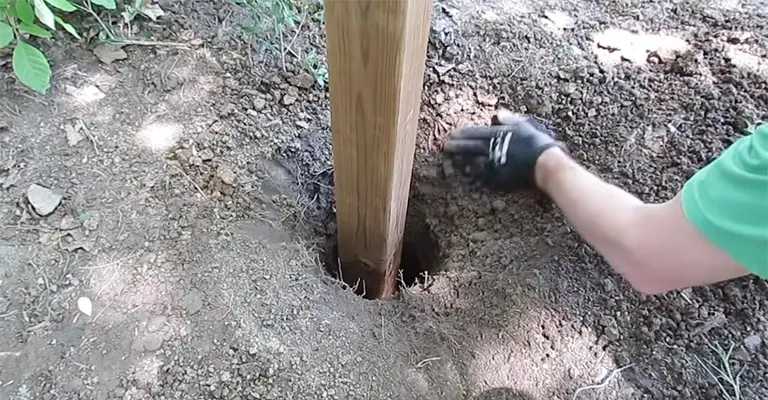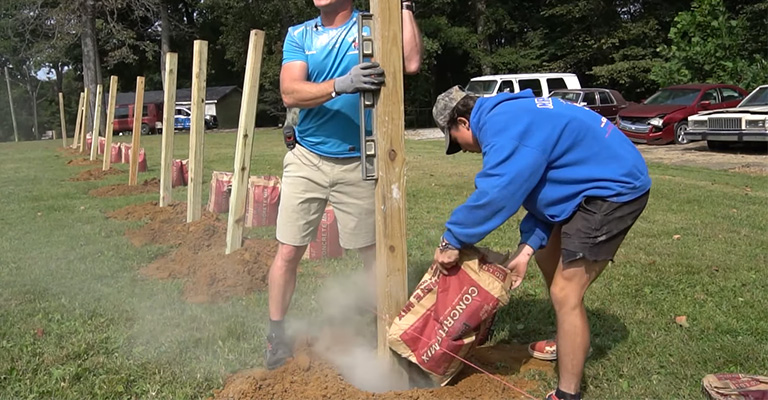Maintaining a sturdy and reliable fence around our property is essential to ensure privacy, security, and aesthetic appeal.
Over time, however, wear and tear can take a toll on fence posts, leading many homeowners to wonder if they can salvage their existing fence by reusing the same holes for new posts.
While this idea may seem tempting, the answer isn’t as straightforward as it may appear. In this blog, we will explore the question that has crossed the minds of many property owners: “Can you put new fence posts in old holes?”
Yes, in many cases, it is possible to put new fence posts in old holes. There is no reason not to use the same holes unless they are not spaced for the new fencing sections.
However, whether it’s a good idea or not depends on several factors. Although it would be nice to slip a new post down the old hole, it is more likely that the new post will not fit unless you carve off a bit of wood and then it will be too loose.
We’ll delve into the factors you should consider before making this decision, the challenges you might encounter, and whether this approach is a viable solution for your fencing needs.
New Fence Post In Old Concrete Hole?
No matter how nice it would be to slip a new post through the old hole, chances are you’ll have to carve on it a bit to make it fit. As a result, it opens up the possibility of being too loose.
This one-foot concrete cap will go a long way to securing the post and keeping it stable. It’s your choice whether you pull the old core completely or try to reuse it, since I don’t think there are that many risks in leaving it in place.
You can also replace the old Postmaster post with a steel Postmaster post, which will easily slide into the old core. Once the core hole around the post is filled with concrete, a crown can be placed above the hole.
Concrete posts should be just a bit raised off the surface and crowned so dirt won’t collect around them, and water won’t collect around them, both of which are what destroy wooden posts. It doesn’t hurt to check a steel post, though it may not be as critical.
Evaluating Old Fence Post Holes

When considering installing new fence posts in old holes, it’s crucial to thoroughly evaluate the condition of the existing holes.
Reusing old fence post holes can save time and effort, but it’s not always the best solution.
In this section, we’ll explore the factors to consider when evaluating old fence post holes and determine when it’s suitable to reuse them and when it’s better to avoid doing so.
Assessing the Condition of Old Fence Post Holes
The first step in determining whether old fence post holes are suitable for reuse is to carefully assess their condition. Here are some essential aspects to consider during the evaluation:
Stability: Check if the old holes are still stable enough to support a new fence post. Stability is vital for the structural integrity of the fence and ensuring it can withstand external forces like wind and pressure.
Decay and Rot: Examine the wood in and around the old holes for signs of decay or rot. Wood that has become weak or damaged over time may not provide adequate support for the new fence posts.
Size and Depth: Measure the diameter and depth of the old holes. Ensure that they match the requirements of the new fence posts. Inadequate sizing may lead to improper installation and compromise the overall stability of the fence.
Alignment: Check if the old holes are aligned properly to maintain the straightness and levelness of the fence. Misaligned holes may cause the fence to be uneven and visually unappealing.
Factors Affecting the Usability of Old Holes

Several factors can impact the usability of old fence post holes. Understanding these factors will help you make an informed decision:
Age of the Holes: Older fence post holes are more likely to have deteriorated over time due to exposure to the elements. Consider the age of the holes when evaluating their suitability for reuse.
Soil Conditions: The type and quality of soil surrounding the old holes play a significant role in their stability. Sandy or loose soil may not provide adequate support, while clayey or rocky soil might be more stable.
Previous Treatment: If the old fence posts were treated with chemicals or preservatives, it’s essential to consider how they may affect the new fence posts or the surrounding environment.
When Can Old Holes Be Reused, and When Should They Be Avoided?
Reusing Old Holes:
- If the old fence post holes are relatively new and in excellent condition, they can likely be reused, saving time and effort on excavation.
- Well-maintained holes with proper alignment, sufficient depth, and stable soil conditions are suitable for reuse.
Avoiding Old Holes:
- If the old holes show signs of decay, rot, or significant damage, it’s best to avoid reusing them. Installing new fence posts in compromised holes can lead to an unstable fence.
- Misaligned or poorly sized holes may not accommodate the new fence posts adequately, resulting in an uneven fence installation.
Best Practices for Installing New Fence Posts in Old Holes
When it comes to installing new fence posts in old holes, following best practices is essential to ensure a sturdy and long-lasting fence. Here are some crucial guidelines to consider:
Choosing the Right Type of New Fence Posts
Material Selection: Select fence posts made from durable and weather-resistant materials, such as pressure-treated wood, vinyl, metal, or composite materials. The chosen material should match your specific needs and preferences.
Size and Length: Ensure that the new fence posts are of the appropriate size and length to fit securely into the existing holes. Proper sizing is essential for maintaining the structural integrity of the fence.
Ensuring Proper Alignment and Stability
Clear the Surrounding Area: Before installing the new fence posts, remove any debris, rocks, or other obstacles around the old holes to provide a clear workspace.
Use a Level and String Line: Utilize a level and string line to ensure that the new fence posts are installed in a straight line and at the desired height.
Check for Plumb: Verify that the new fence posts are perfectly vertical using a level. Proper alignment is crucial for the fence’s aesthetics and functionality.
Temporary Bracing: While installing the new fence posts, use temporary braces to keep them in place until the concrete sets and provides stability.
Using Concrete and Backfilling Techniques for Added Strength
Concrete Mix: Prepare a high-quality concrete mix according to the manufacturer’s instructions. Pour the concrete into the old holes around the new fence posts to secure them in place.
Tamp and Compact: Tamp and compact the concrete to remove air pockets and ensure a solid foundation for the new fence posts.
Backfilling: After the concrete has set, backfill the remaining space around the new fence posts with soil, ensuring it is firmly packed to enhance stability.
Allow for Proper Curing: Follow the concrete manufacturer’s recommended curing time before applying any stress or weight to the fence.
Potential Risks and Challenges
Installing new fence posts in old holes can present certain risks and challenges that should be considered to avoid potential issues. Here are the main concerns:
Compromised Stability and Safety Concerns
Weakened Support: Reusing old holes with decayed or damaged wood can compromise the stability of the fence, leading to potential collapse or leaning.
Safety Hazards: An unstable fence poses safety hazards to both property and individuals, making proper installation crucial.
Addressing Soil and Environmental Factors
Soil Erosion: Depending on the soil type, erosion around the old holes can occur over time, affecting the stability of the new fence posts.
Moisture Content: Soil moisture levels should be taken into account, as excess moisture can lead to wood decay and corrosion of metal posts.
Long-term Implications of Using Old Holes
Lifespan of the Fence: Reusing old holes might not provide the same longevity as starting fresh with new holes and posts.
Maintenance Requirements: Fences installed in old holes may require more frequent maintenance due to potential stability issues.
Alternatives to Reusing Old Fence Post Holes
If reusing old fence post holes is deemed unsuitable or risky, exploring alternative options for fence installation is a wise choice. Here are some alternatives to consider:
Exploring Alternative Options for Fence Installation
Digging New Holes: Excavating new holes can provide a fresh foundation for the fence, ensuring stability and longevity.
Post Anchors: Utilize post anchors to secure the fence posts without digging deep holes, suitable for specific soil or terrain conditions.
Tips for Filling Old Holes and Starting Fresh
Filling Old Holes: If not reusing old holes, fill them with concrete or gravel to prevent them from becoming hazards or collecting water.
Proper Measurements: When digging new holes, use precise measurements and spacings to ensure a level and aesthetically pleasing fence.
Factors to Consider When Deciding on the Best Approach
Budget: Evaluate the cost implications of reusing old holes versus starting fresh.
Time Constraints: Consider the time required for each approach, as reusing old holes may be quicker.
Safety and Longevity: Prioritize the safety and longevity of the fence when making the final decision.
The Bottom Line
Reusing old fence post holes can be a viable option under certain conditions. If the old holes are still in excellent condition, stable, and properly aligned, they can save time and effort during the installation process.
However, it is crucial to ensure that the holes are free from decay or significant damage, as this can compromise the stability and safety of the new fence.
For optimal results, it is recommended to seek the opinion of a professional fence installer or contractor.
They can conduct a thorough assessment of the old holes and provide expert advice on whether reusing them is a safe and feasible option.








